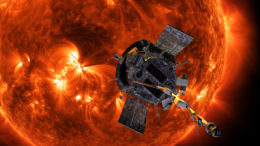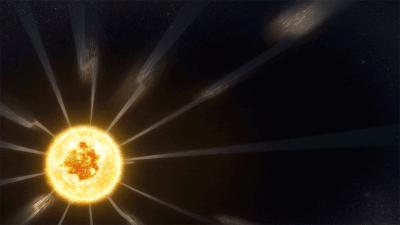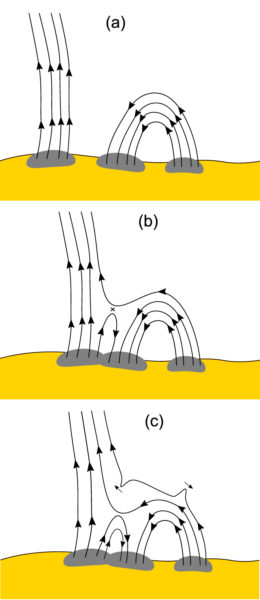
Artist’s illustration of the Parker Solar Probe. A special ApJS issue features around 50 articles detailing early results from this mission. [NASA/Johns Hopkins APL/Steve Gribben]
A Kink in the Plan
Launched in 2018, the Parker Solar Probe (PSP) is on a mission to orbit the Sun, dipping ever deeper into our star’s outer corona to make measurements of the magnetic field and plasma conditions there. The probe is currently approaching its eighth perihelion pass, where it will graze an altitude just 15 solar radii or so above the Sun’s surface! But the PSP was already making surprising detections on its very first perihelion pass in 2018.

Animation of magnetic switchbacks propagating outward through the corona. [NASA’s Goddard Space Flight Center/Conceptual Image Lab/Adriana Manrique Gutierrez]
The discovery of this phenomenon put theorists to work. What causes switchbacks, and what might they tell us about the production of the solar wind and plasma processes around the Sun? In a study led by Gary Zank (University of Alabama in Huntsville), a team of scientists present a model that may explain these strange phenomena.
Searching for (Re)connection

Diagram of the authors’ model for production of switchbacks by interchange reconnection: a) a closed coronal loop and open magnetic field lines approach each other; b) the first field line reconnects, producing an open field line with an S-shaped structure; c) the switchback is launched, propagating both upward and downward, as a new reconnection event begins on the next field line. [Adapted from Zank et al. 2020]
The authors derive the mathematical theory describing how a switchback produced from this reconnection would propagate through the inhomogeneous solar corona. The reconnection event launches magnetic field deflections both out into the solar system and down toward the solar surface. The authors show that the most extreme of these deflections take the form of the S-shaped structures that PSP observed as the most dramatic switchbacks.
Matching Theory to Observation
Zank and collaborators demonstrate that their model is both qualitatively and quantitatively consistent with PSP’s observations of switchbacks in its first perihelion pass. Not only does the theory well reproduce a single switchback, but it also shows how interchange reconnection events can occur in quick succession for loops made of multiple magnetic field lines, resulting in clustering of switchbacks consistent with PSP’s measurements.
We’re still in early stages of understanding these strange phenomena, but more help is on the way! PSP continues to amass a vast trove of data as it repeatedly swings through the Sun’s atmosphere — which we can hope will soon bring the mystery of switchbacks to a close.
Citation
“The Origin of Switchbacks in the Solar Corona: Linear Theory,” G. P. Zank et al 2020 ApJ 903 1. doi:10.3847/1538-4357/abb828
